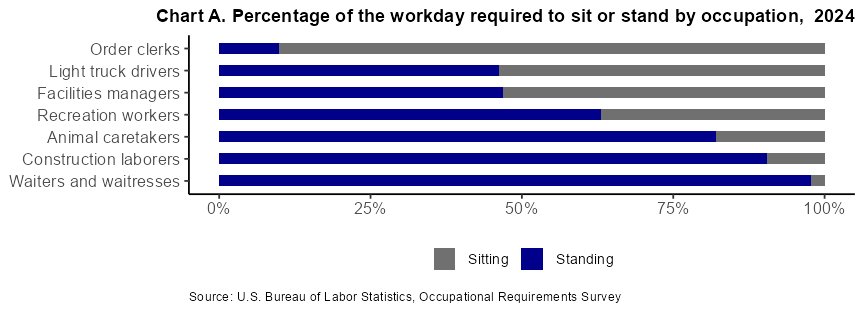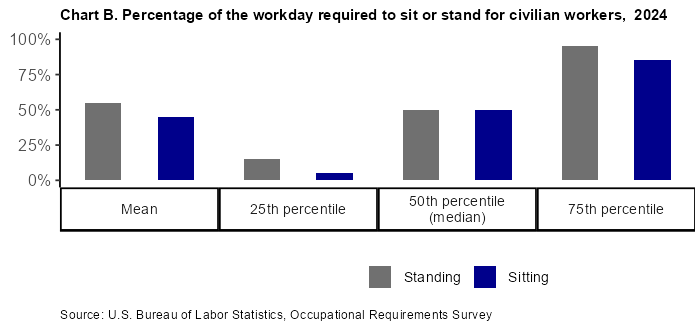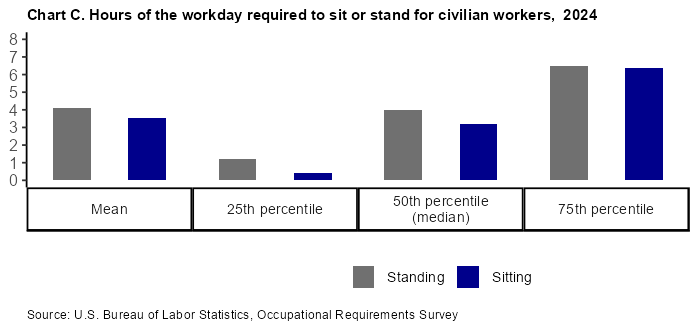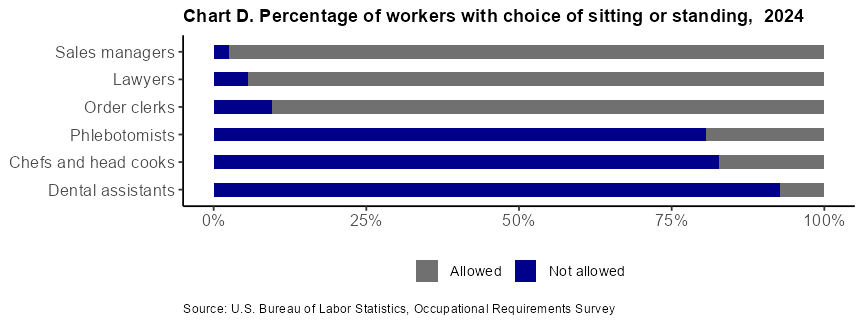An official website of the United States government
 United States Department of Labor
United States Department of Labor
The Occupational Requirements Survey (ORS) publishes job-related information on physical demands; environmental conditions; education, training, and experience; as well as cognitive and mental requirements. The job requirements reflect those necessary for workers to perform critical tasks in support of the critical job functions, and not the capabilities of individual workers. Sitting and standing are considered part of the physical demands for workers in the U.S.
This factsheet covers the following physical demands: sitting, standing, and the choice to sit or stand. The amount of time spent sitting or standing is provided in the number of hours per workday, as well as the percentage of the workday.
To calculate the amount of time spent working while sitting or standing, workers are assumed to be in either position throughout the workday. That is, the total amount of the workday is equal to the amount of time working while sitting and standing. For example, if workers sit for 4 hours and the workday consists of 10 hours, then the percentage of the workday sitting is 40 percent. If the workday consisted of 8 hours, workers would be sitting for 50 percent of the workday.
Active sitting. For example, a police officer riding a bicycle to patrol traffic or a landscaper mowing a residential lawn in a seated mower.
Active lying down. For example, a mechanic lying on a dolly working underneath a vehicle is considered sitting.
When workers may choose between sitting and standing, that work time is included in sitting for the hours and percentage of workday estimates.
On average, pharmacy technicians spent 13.6 percent of the workday sitting, while file clerks sat for 79.1 percent of the workday.

Standing is present when workers are not sitting or lying down. Standing includes:
Walking. For example, tellers walk to escort customers to a safety deposit box.
Climbing. For example, electricians climb ladders to reach wires placed in ceilings.
Low postures such as stooping, crawling, kneeling, and crouching. For example, pest control workers crawling in an attic to apply pesticides.
Workers who stand their entire shift except during paid breaks.
On average, light truck drivers spent 45.9 percent of the workday standing, while construction laborers stood for 89.2 percent of the workday.
Duration of sitting and standing
In addition to the average percentage of the workday spent sitting or standing, the ORS also publishes the percentile distribution of the percentage of the workday as well as percentile distribution of hours spent performing these physical requirements.
On average civilian workers spent 44.9 percent of the workday sitting and 55.1 percent standing. Percentile estimates provide a range of requirements among workers. For example, at the 10th percentile, workers were required to stand for less than 0.5 percent of the workday while at the 90th percentile, workers stood for 100.0 percent of the workday. At the 50th percentile (median), 50 percent of civilian workers spent 50.0 percent or less of the workday standing and 50 percent of workers spent 50.0 percent or more of the workday standing.

In 2025, civilian workers spent an average of 3.55 hours sitting and 4.14 hours standing.

The choice of sitting or standing is present when workers can alternate between sitting and standing. Choice of sitting or standing is present when the following conditions exist:
Workers typically have the flexibility to choose between sitting and standing throughout the workday.
There is no assigned time during the day to sit or stand.
No external factors determine whether an employee must sit or stand.
The choice of sitting or standing was available to 87.4 percent of industrial engineers while the choice was not available to 97.7 percent of animal caretakers.

Additional resources:
Articles:
Minds at work: what’s required according to the Occupational Requirements Survey (PDF)
A look at teachers’ job requirements, employer costs, and benefits (PDF)
Occupational Requirements Survey: Third wave testing report (PDF)
Occupational Requirements Survey: results from a job observation pilot test
The Occupational Requirements Survey: estimates from preproduction testing
For additional information on occupational requirements see the ORS homepage or download the ORS complete dataset to explore the latest estimates.